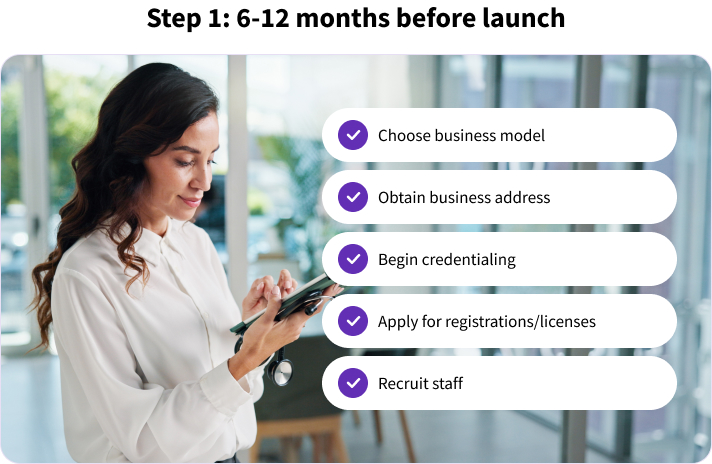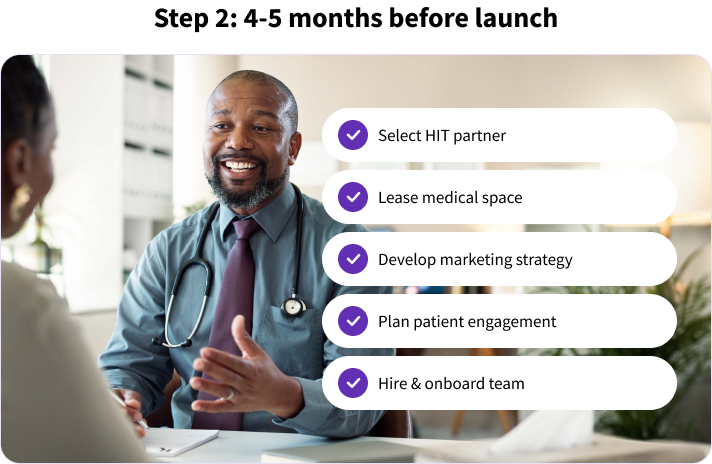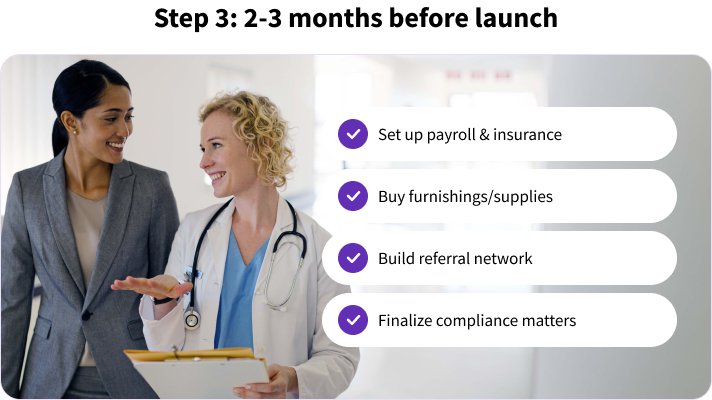Thinking of starting a medical practice? Know what to plan for.
Starting your own medical practice from the ground up can be an exciting and rewarding step in your career. It’s an opportunity to provide care on your terms, create meaningful patient experiences, build a thriving business, and establish a legacy.
Of course, it’s not as simple as renting medical space and hanging out your shingle. Starting a private practice means running a healthcare business, and healthcare is complex and challenging. For instance, getting paid for patient care has never been more difficult. According to a 2024 MGMA Stat poll, 60% of medical group leaders reported an increase in their practices’ claim denial rates for the current year compared to the same period in 2023.1
Launching a successful new practice today takes more than medical expertise — it requires careful planning, the right technology, and a strong support system. One of the best ways to begin is by learning from other independent physicians who have already navigated this journey. That’s why we’ve put together this high-level medical practice checklist, developed in collaboration with a recent athenahealth start-up customer, to guide you through the essential steps of starting a private practice of your own.
Step 1: Establish the foundation
Long before you see your first patient, you need a solid business and legal structure supporting you. This step ensures your new medical practice operates smoothly and complies with all regulatory requirements.

- Choose a business model and legal structure. Work with a lawyer to determine the best corporate structure (e.g., S Corp, LLC). Incorporating your practice will generate a Tax ID Number (TIN), which is essential for operations.
- Obtain a business address. You don’t need a permanent location at this stage, but you will need a business address for paperwork, credentialing, and banking purposes.
- Begin credentialing with insurance payers. Credentialing can take four to six months or longer, so start as early as possible. Consider working with a specialist who has local knowledge of insurance payers to streamline the process. Practices using athenahealth have an advantage here: their onboarding team can help work with the credentialing company to assist in proper set- up for the credentialing process, and our built-in integrations with the nation’s largest payers provide automatic connections to the most popular insurance providers without programming delays.
- Apply for key registrations and licenses such as a National Provider Identifier (NPI) for your group practice or a DEA & State Controlled Substance License (if applicable).
- Start recruiting staff. Successfully starting a medical practice depends on having a strong team by your side. Begin your search early to ensure you find qualified professionals aligned with your vision.
Step 2: Build your infrastructure and technology
Your new medical practice needs the right technology, staffing, and outreach strategy to operate efficiently and grow. Here’s what to focus on at this stage.

- Select your Healthcare IT partner. A critical decision when you’re starting a medical practice is selecting an EHR, practice management, and revenue cycle solution. You’re looking for a partner in your success, not merely a vendor to install software. Choosing a cloud-based system can reduce your upfront costs and ensure your technology stays current without costly upgrades. athenahealth’s all-in-one electronic health record, revenue cycle management, and patient engagement HIT solution, athenaOne®, is designed for long-term success. It’s an integrated platform that connects you to clinical workflows, billing, and patient communication through a single point of access. And because it’s cloud-based, you can sign in from any computer or mobile device with an internet connection.
- Secure medical practice space and sign a lease. Figure out your must-haves and nice-to-haves for your space. For instance, where do you want to set up shop, and what other medical practices may be competing for the same patients? How much space will you need for staff, clinicians, and exam rooms? You may wish to work with a specialized commercial real estate broker who can help you identify the best possible spot. Once you have a location, you can start planning the layout and logistics of your practice.
- Develop your marketing strategy and online presence. First, create a professional website that clearly communicates your services, location, bio and experience, and contact information. It’s worthwhile to set up business listings on platforms like Google Business and Healthgrades to ensure potential patients can easily find (and eventually review) your new medical practice. And don’t underestimate the power of a strong social media strategy to connect with your community, engage with potential patients, and share valuable healthcare insights that help you build trust and visibility.
- Engage patients from the get-go. Patient engagement and outreach should be a priority from the start. Your website, online appointment scheduling, and patient communication tools must be in place early to build awareness and attract your first patients. Consider an automated patient reminder system and digital check-in options to streamline the experience for both patients and staff. Pro tip: Implementing an all-in-one Healthcare IT solution like athenaOne connects you with powerful patient engagement tools so you can hit the ground running.
- Hire and onboard your team. Identify key roles such as front office administrators, medical assistants, and billers. A strong team ensures efficient scheduling, billing accuracy, and positive patient experiences. It’s also possible to outsource tasks like medical coding and save time while gaining accuracy.
Your new medical practice needs the right technology, staffing, and outreach strategy to operate efficiently and grow.
Step 3: Secure your operations and prepare for launch
With technology and staffing in place, it’s time to finalize logistics and make sure you’re in shipshape before your first patients come through the door.

- Set up payroll, workers’ compensation, and business insurance. Work with a tax professional to ensure compliance and establish financial processes for paying staff and managing revenue.
- Acquire medical and office furnishings and supplies. This includes everything from exam tables, refrigerators for medication storage, and waiting room furniture to diagnostic tools, PPE, and consumables. Don’t forget the administrative essentials like computers, scanners, and phones, as well as clipboards and pens with your practice name on them.
- Build a referral network. Your new medical practice should have call coverage for after-hours patient needs. Developing a network of independent clinicians you can rely on will give you peace of mind – and a community of peers. Reach out locally, join professional organizations, connect with your alumni association, and keep up your social media presence to start forging those crucial links.
- Button up compliance and risk mitigation. Almost ready for opening day! You’ve invested time, money, and effort into starting your own doctor’s office, so make sure you’ve taken steps to protect it before you unlock the door. This is the time to finalize your malpractice insurance and confirm that all credentialing and regulatory paperwork is complete.
Step 4: Open your doors and grow
With everything in place, it’s time to officially launch your new private practice and establish your presence in the community. Set the date for your grand opening, build some community momentum, then deliver quality care with compassion that drives strong reviews and patient loyalty.

- Get the word out. Announce your opening to local hospitals, specialists, pharmacies, and alternative care providers and wellness businesses to start building referral relationships. Your marketing plan may include outreach to local media, advertising in your community, and your social media presence. If there are details that set you apart – such as special services you offer or evening/weekend practice hours – make sure that message comes through loud and clear.
- Invite the community in. Hosting an open house can be a great way to introduce yourself and your new medical practice to the community. In your brochures and your conversations with future patients, don't be shy to talk about your experience, your mission, and your connection to the community. Everyone likes doing business with people they can relate to and feel comfortable with. The better your potential patients understand you and your approach to care, the more likely they’ll be to give your new practice a try.
- Track, refine, and optimize. Once you start seeing patients, it’s also time to start tracking your performance. athenahealth benchmarks new practices against thousands of others to help you measure progress in key areas like patient volume, claims processing time, and revenue cycle efficiency. Knowing where you stand and how you compare to others can help you get a sense of both how much you’ve accomplished, and where you have room to grow.
Setting the stage for long-term success
Starting a medical practice of your own is a significant milestone, and the result of a lot of training, groundwork, and grit. The first year brings a different kind of challenge: balancing clinical care with the realities of running a business. It’s a time of learning, adapting, and laying the foundation for lasting relationships with your patients and your team. That includes doing all you can to prevent staff burnout and turnover during those critical first 12 months. Workplace experts have suggested that it takes about a year for new hires to reach their full performance potential within a role,2 so it's important to implement solutions that support staff and reduce strain.
At athenahealth, we’ve helped thousands of independent practices — brand-new start-ups and established practices alike — find their footing. One ingredient of our secret sauce: your dedicated Customer Success Manager, who works alongside you from day one to help your practice reach the heights you’ve envisioned. Customer Success Managers provide tools and insights to help you refine billing processes, make the most of patient outreach opportunities, benchmark and optimize your performance, and even scale and grow when you’re ready.
And with athenaOne, you get a future-proof, all-in-one solution that supports clinical workflows, billing, and patient communication on a single platform, instead of having to manage multiple vendors, contracts, and relationships to stay innovative.
It's true that starting a private practice can be overwhelming, and it’s easy to fall into the trap of focusing only on near-term needs and low-cost solutions that are quick to implement. But it’s important to think about your long-term vision for your practice, too. Select a solution that can grow with you, help you run your business efficiently, and empower you to deliver high-quality care at every stage.
From opening day at your new practice to its future growth and evolution, we’re here to help you navigate industry change and succeed. Ready to start a medical practice that aligns with your vision — today and tomorrow? Book a call with our business development team and let’s talk about your timeline. Start turning your start-up dream into reality, right here.
More medical start-up resources
Continue exploring
1.MGMA, Mar. 2024, Stat Poll, https://www.mgma.com/mgma-stat/strategic-improvements-in-your-rcm-to-reduce-your-practices-claim-denials; IS135
2. Gallup, Aug. 2021, Creating an Exceptional Onboarding Journey for New Employees; https://www.gallup.com/workplace/353096/practical-tips-leaders-better-onboarding-process.aspx; IS062










